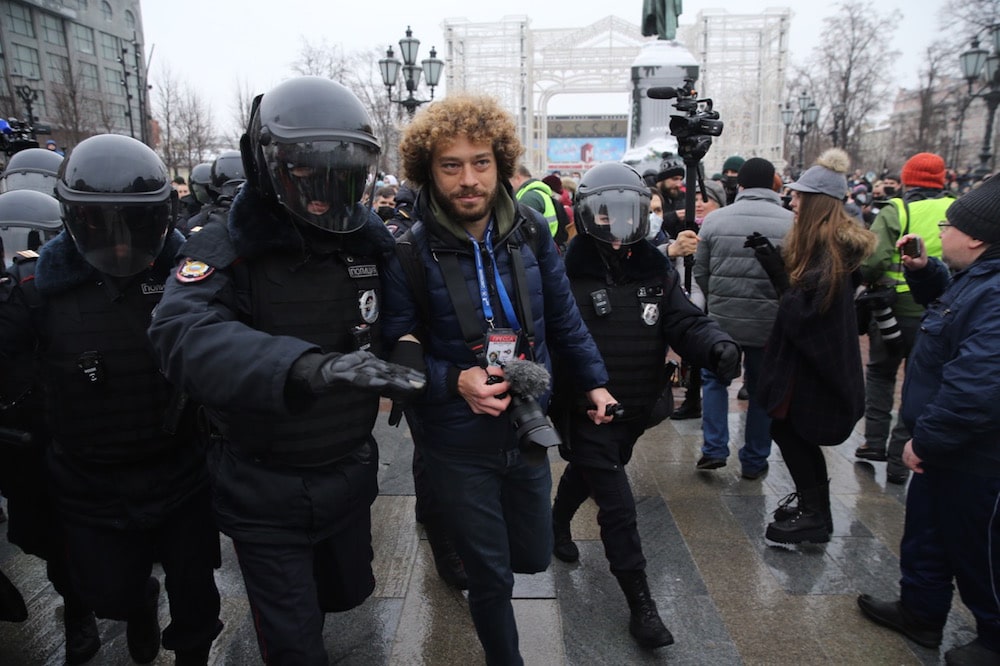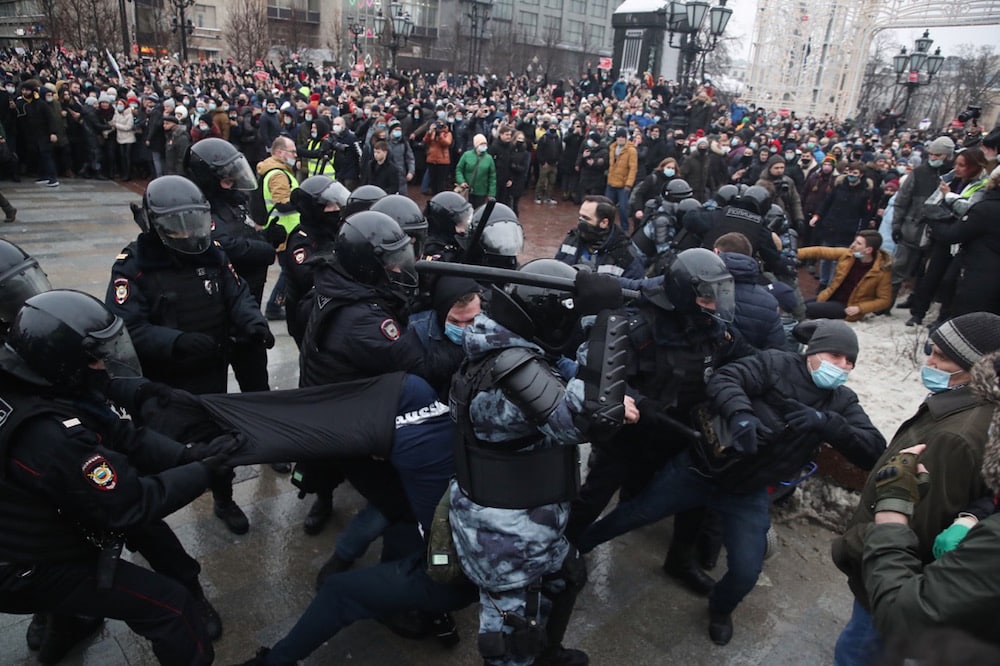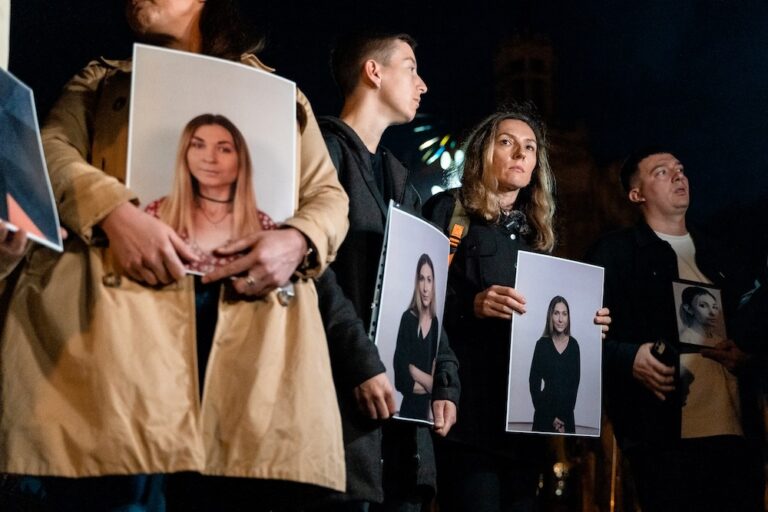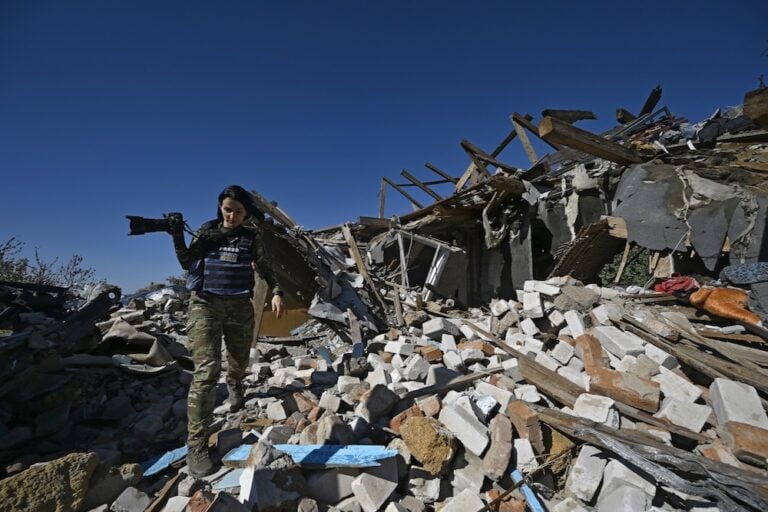“Time and time again, Russian authorities have suppressed free speech and peaceful protest through police brutality, violence, and mass arrests. The authorities understand their obligations to respect fundamental human rights and choose not just to ignore them but to trample all over them.”
This statement was originally published on hrw.org on 25 January 2021.
On January 23, 2021, police detained more than 3,700 people across Russia at nationwide protests against the arrest of political opposition figure Alexey Navalny and against state corruption, Human Rights Watch said today. It was the largest number of people detained on a single day in the country according to OVD-Info, a Russian human rights group that monitors public assemblies.
There were numerous reports of excessive use of force by police, including beatings, much photographed or filmed by media outlets or private citizens and posted to social media. Although there were some incidents of protester violence, the vast majority of the protests were peaceful.
An independent assemblies’ monitoring expert estimated that the January 23 protest in Moscow was the largest in seven years. Several media outlets estimated that over 100,000 people took to the streets in over 100 cities across Russia.
“Time and time again, Russian authorities have suppressed free speech and peaceful protest through police brutality, violence, and mass arrests and January 23 was no exception,” said Damelya Aitkhozhina, Russia researcher at Human Rights Watch. “The authorities understand their obligations to respect fundamental human rights and choose not just to ignore them but to trample all over them.”
Authorities had earlier refused to sanction the peaceful protests called for by Navalny and his team, often referencing restrictions imposed due to the Covid-19 pandemic. Many of Navalny’s team and well-known activists, at least 60 people, were detained ahead of or on the day of the protest in different parts of Russia.
A lawyer, Mikhail Benyash, was detained in Krasnodar on January 22 for his social media post urging colleagues to organize legal aid for potential detainees. On January 23, police detained Yuliya Navalnaya, Navalny’s wife, in Moscow after the protest. Her lawyer was not allowed to accompany her to a police station. She was released a few hours later. Riot police detained Liubov Sobol, a political activist and lawyer with the Foundation Against Corruption (FBK), founded by Navalny, while she spoke to journalists at a protest.
The protests began in Vladivostok, in Russia’s Far East (seven hours ahead of Moscow). In Novosibirsk, Tyumen, Yekaterinburg and other cities in Siberia, several thousands gathered despite temperatures ranging between -20 and -30C. Yakutsk was the site of the coldest protest, where several dozen protesters gathered despite the -50C temperature and ice fog. Initially police did not interfere with gatherings and rallies, which proceeded peacefully.
A Human Rights Watch researcher analyzed hours of footage, live video feed, and photos from cities across the country depicting demonstrations, rallies, police violence, and detentions. The researcher also reviewed media coverage, including journalists’ interviews with eyewitnesses.
Across the country protesters gathered in central squares, some holding placards and chanting slogans such as “Freedom,” “Shame on you,” “Putin is a thief”, “We won’t forget, we won’t forgive,” “Freedom to political prisoners,” and “Russia without Putin.”
In some cities, protesters were met with an overwhelming police presence. Police remained in vehicles parked near central squares and locations, then advanced on the crowds to break up the protests and arrest participants. In Yekaterinburg, journalists caught on camera police units equipped with assault rifles and regular riot police in full gear.
In Moscow and St. Petersburg, the large numbers of protesters filled up the protest venues and surrounding streets. Police had cordoned off Moscow’s Pushkin Square, the planned location of the demonstration. Ahead of the scheduled protest time, authorities used loudspeakers and repeatedly warned people to avoid mass gatherings, maintain social distancing, and wear masks and gloves in accordance with Covid-19 related public health rules. Later they announced the gathering was illegal and demanded that protesters leave. Occasional detentions on the square started over an hour before the scheduled protest time.
Human Rights Watch viewed video footage showing police beating people with batons, pushing people to the ground, and kicking them. Human Rights Watch also gathered online accounts of people seeking medical attention for injuries due to police violence.
The authorities in some cities have launched criminal cases against individuals accused of calling for mass riots, violence against police, and violating Covid-19 related public health rules.
Data is not yet available on the numbers of protesters in detention or how many are facing administrative charges for violating public assembly rules or disobeying police orders.
In previous years, Russian authorities retaliated against participants in mass protests with showcase witch-hunt trials, which resulted in long prison terms, Human Rights Watch said.
“The unprecedented detentions and extreme police brutality across Russia are evidence of how low human rights standards have plummeted in the country,” said Aitkhozhina. “Ultimately this repression of basic human rights only galvanizes people and deepens their grievances.”

Police officers detain a blogger and journalist (C) during the protest against the jailing of opposition leader Alexei Navalny, in Central Moscow, Russia, 23 January 2021, Mikhail Svetlov/Getty Images
Police violence against protesters and journalists
According to numerous accounts, gatherings remained peaceful, and in some places people were already starting to leave the scene, when police started to disperse the crowds, in some locations using excessive force including vicious beatings of protesters.
In Moscow as the crowd grew in the already restricted space at Pushkin Square, some protesters lifted a few of the metal bars that police had placed to divide the square into smaller areas. In Yekaterinburg, a few young men started altercations and threw snow at police in an attempt to free detained protesters whom police were escorting to police vehicles. These incidents apparently triggered more intense police action to disperse the gatherings.
Groups of riot police in Khabarovsk ran into the crowd, apprehending protesters apparently at random and dragging them to police vehicles. Similar tactics were used in Moscow and other cities. There were many reports of police brutality during detentions of protesters in several regions. Police beat protesters, forcing detained people to lay face down on the ground – in some places, like Yekaterinburg, in the snow at freezing temperatures – stomped on them and dragged them towards police vehicles.
In Moscow and St. Petersburg police were caught on camera repeatedly hitting protesters on the head and hands with batons. In the same footage police can be seen repeatedly beating a man who is lying on the ground and being dragged around; another older woman can be seen with marks on her face. In one instance caught on camera, police in Moscow repeatedly hit a detained young man with truncheons on his back, while police repeat through loudspeakers: “We’re doing everything to ensure your safety.”
In St. Petersburg a police officer kicked a woman in the stomach, knocking her to the ground, when she approached him to ask why police were detaining a young man. She sustained a concussion and hematoma; the following day she had to be transferred to intensive care.
Journalists in Orenburg reported that for the first time in the city’s recent history, police beat peaceful protesters. Videos show police repeatedly hitting protesters – who are lying on the ground and trying to cover their heads – with truncheons and kicking them, while a large crowd of protesters stands some distance around them chanting “Shame [on you]” and shouting “Why are you beating them?”
In Moscow, a journalist interviewed a man with a bloodied head, who said that he was attacked by police when he tried to help a girl who fell down after police had grabbed her. He is reported to have said: “I couldn’t not interfere, seeing police pulling her by her hair.”
A young man with a visibly injured head explained to a journalist on video that he was at the front of a group of protesters when police blocked them from moving forward, and that he sustained lacerations to his head as a result of a police beating.
Journalists in Orenburg reported that for the first time in the city’s recent history, police beat peaceful protesters. Videos show police repeatedly hitting protesters – who are lying on the ground and trying to cover their heads – with truncheons and kicking them, while a large crowd of protesters stands some distance around them chanting “Shame [on you]” and shouting “Why are you beating them?”
Another journalist reporting on police brutality in Moscow witnessed police dragging a woman by the hair. The same journalist reported how police beat her and other journalists on their heads and hands and stomped on them despite their clearly visible press jackets and badges.
An independent trade union of journalists and media workers stated they documented over 50 incidents of police assaulting journalists and detaining them in at least 17 cities. Almost all of them had press cards, and the majority wore yellow jackets or armbands with press clearly written on them.
In Moscow, protest crowds started to divide and diminish in the evening. One group of protesters went to the Matrosskaya Tishina detention center, where Navalny remains in custody, while another relocated to Lubianka Square, the headquarters of the Russian Security Service (FSB), which has been accused of being behind Navalny’s poisoning. Police detained several dozen protesters outside Matrosskaya Tishina, and were captured on video using excessive force.
Detentions continued in the evening along the boulevards in central Moscow, apparently at random, as people were walking on boulevards and heading towards subway stations.
Media reported that at least one detainee in Vladivostok arrived at the police station unconscious. In Moscow, some detainees remained locked inside cramped police vehicles, without the possibility of social distancing, for over two hours. Maria Litvinovich, a member of Moscow’s Public Monitoring Commission (ONK), an independent expert body authorized to monitor detention sites, posted on Facebook that one detainee in Moscow had his shoulder dislocated during arrest and received treatment at the emergency room before being returned to the police station in pain with his arm bandaged. The following day, she reported that several police stations in Moscow refused to grant access to the commission to allow them to document conditions of detention.
Children
[ … ]
Protester Violence
[ … ]
Criminal Cases
On January 22, a number of Russia’s state bodies threatened protesters with prosecution.
The Russian Interior Ministry announced that they initiated an inquiry against the regional heads of Navalny’s team for “organizing provocations and violent actions.” They alleged that these teams were instructed by Ivan Zhdanov, director of FBK and Leonid Volkov, the head of Navalny’s regional teams, to recruit minors to take part in unauthorized protests by disseminating false information.
The Investigative Committee, Russia’s criminal investigation service, initiated a criminal case for involving children in the planned protests, claiming they were endangering their health and lives due to the pandemic. This is punishable with up to three years imprisonment.
The General Prosecutor’s Office stated that in the event of “attempts at violent actions” they can invoke mass riot charges, punishable by up to 12 years for organizers and 8 years for participants.
At least 10 criminal cases were opened in five cities on charges of using violence against police officers and mass riots. The same charges were used following high profile mass protests in Bolotnaya in 2012 and Moscow in 2019. These resulted in dozens of detentions, lengthy prosecutions and numerous imprisonments, despite often dubious evidence or even evidence exonerating the accused.
Criminal charges for interfering with police arrests and assaulting police officers are legitimate, but in previous cases that Human Rights Watch has documented, charges were pressed and guilty verdicts handed down in cases where the photo-video evidence showed only limited or no contact with police or negligible harm. In some instances, accounts by police were shown to be exaggerated or possibly untruthful. The circumstances of those cases strongly suggest these charges are often brought to discourage the legitimate exercise of the right to peaceful protest.
At the same time, Russian authorities continue to refuse to conduct effective investigations or to prosecute police for excessive use of force against peaceful protesters.
According to a lawyer for the Foundation Against Corruption, on January 24 Russia’s Investigative Committee opened a new criminal case for violation of sanitary and epidemiological regulations, punishable by up to 2 years’ imprisonment.
In another example of how far authorities are prepared to go to pursue criminal sanctions against protesters, irrespective of the tenuous connection of the charges to the events of January 23, Moscow police announced on January 24, that they have opened a case into alleged damage to vehicles or roads caused by protesters temporarily blocking traffic during the protests. The offence is punishable by up to a year in prison.
Applicable International Law
The efforts to prevent people from participating in peaceful public protests violate rights to freedom of expression and assembly and the prohibition on arbitrary detention, guaranteed by the European Convention on Human Rights (ECHR), the International Covenant on Civil and Political Rights (ICCPR), and in Russia’s own constitution.
International law requires any limitations on peaceful assemblies and free speech to be both necessary and proportionate. As the European Court of Human Rights has made clear, the freedom to take part in a peaceful assembly is of such importance that a person cannot be subject to a sanction, even a minor one, for participation in a demonstration that has been prohibited, so long as this person does not commit an act of violence or similar crime.



